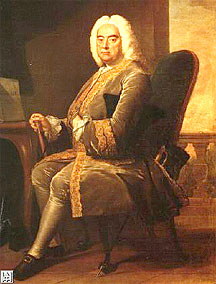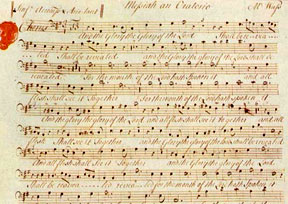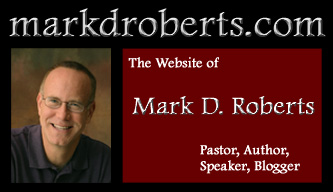| Handel's Messiah; The Messiah by Handel; Messiah; Easter; Lent; Advent; Christmas
Handel's Messiah and Easter
by Rev. Dr. Mark D. Roberts
Copyright © 2007 by Mark D. Roberts
Note: You may download this resource at no cost, for personal use or for use in a Christian ministry, as long as you are not publishing it for sale. All I ask is that you give credit where credit is due. For all other uses, please contact me at mark@markdroberts.com. Thank you.
An Unexpected Easter Masterpiece
Posted for Monday, April 16, 2007
Part 1 of series: Handel's Messiah and Easter
Permalink for this post / Permalink for this series
I ended my last post by promising to discuss one further piece of Easter music. Today I begin to keep my promise.
Recently the choir of my church, along with a couple of guest choirs, did something you might consider odd. They sang a wonderful, well-known piece of music. This isn't odd, of course. But the strange part, at least in the perspective of some folks, was the timing of the concert. For the choirs sang Handel's Messiah in Lent, a couple of weeks before Good Friday and Easter.
Most of us associate the Messiah with with Christmas, or perhaps with Advent, the season of preparation for Christmas. In fact, a few of years ago I was blessed to join my church choir as we sang a substantial proportion of the Messiah for our Christmas concert. (To hear a short clip of our choir singing the Hallelujah chorus, click here [.mov 284K]). Moreover, I make it a habit to listen to the entire Messiah during Advent to prepare myself for a deeper celebration of Christmas.
 But, in truth, Handel did not write the Messiah as a piece of Christmas music. We know this for a couple of reasons. First, if you pay close attention to the words of the Messiah in the libretto written by Charles Jennens, you'll discover that only the first part of the composition has to do with the birth of Jesus. The second and third parts focus on His death, resurrection, sending of the Spirit at Pentecost, and the final resurrection of all believers. Second, the first performance of the Messiah occurred, not during Advent or Christmas, but in Eastertide. Handel's masterpiece was first performed in Dublin on April 13, 1742, 19 days after Easter. This is surely no accident. If Handel had envisioned the Messiah as a piece for Christmas, it would have been introduced in this season. (Picture to the right: George Frideric Handel [1685-1759]) But, in truth, Handel did not write the Messiah as a piece of Christmas music. We know this for a couple of reasons. First, if you pay close attention to the words of the Messiah in the libretto written by Charles Jennens, you'll discover that only the first part of the composition has to do with the birth of Jesus. The second and third parts focus on His death, resurrection, sending of the Spirit at Pentecost, and the final resurrection of all believers. Second, the first performance of the Messiah occurred, not during Advent or Christmas, but in Eastertide. Handel's masterpiece was first performed in Dublin on April 13, 1742, 19 days after Easter. This is surely no accident. If Handel had envisioned the Messiah as a piece for Christmas, it would have been introduced in this season. (Picture to the right: George Frideric Handel [1685-1759])
Although you may be familiar with the Messiah, it offers many surprises if one carefully examines the libretto. For one thing, the lyrics of this piece are entirely from the Bible (though in a few spots Jennens paraphrased the Authorized Version). For another, though the story of Jesus is a New Testament narrative, the majority of the words in the Messiah come from the Old Testament. Moreover, the key events – the birth, death, and resurrection of Jesus – are not told with New Testament texts, but with prophetic passages from the Old Testament. For example, the Messiah doesn't include the words, "And she brought forth her firstborn son, and wrapped him swaddling clothes" (Luke 2:7). Instead, it celebrates, "For unto us a child is born, unto us a son is given," quoting Isaiah 9:6.
For centuries people have loved Handel's Messiah, and for good reason. In fact, a reviewer of the first performance of this piece wrote, "The sublime, the grand, and the tender, adapted to the most elevated, majestic and moving words, conspired to transport and charm the ravished heart and ear." Now that's some review!
In my next post I will begin to inspect the libretto of the Messiah, looking especially at its presentation of the death and resurrection of Jesus, the composition's Easter core, if you will.
Handel's Messiah: A Closer Look
Posted for Tuesday, April 17, 2007
Part 2 of series: Handel's Messiah and Easter
Permalink for this post / Permalink for this series
In my last post I explained why Handel's Messiah, a piece we ordinary associate with Christmas, is really an oratorio for Easter. Today I want to examine the libretto (the words of the composition) to show the strong Easter themes.
The Messiah comes in three parts. I'll provide a short summary of each part.
Part I
Part I focuses on the birth and life of Jesus. It begins with prophetic promises of the birth of the Christ, many from the Old Testament book of Isaiah. These include, for example, the Alto recitative: "Behold, a virgin shall conceive, and bear a son, and shall call his name Emmanuel: God with us" (based on Isaiah 7:14). The actual birth of Jesus is revealed, not through the words of Luke 2, but through the prophecy from Isaiah 9:6: "For unto us a child is born . . . ." Then the Messiah narrates the experience of the shepherds outside of Bethlehem, completing the birth story.
The next section of Part I describes the ministry of Jesus as a fulfillment of prophecy, "Then the eyes of the blind be opened. . ." (based on Isaiah 35:5); "He shall feed his flock like a shepherd" (based on Isaiah 40:11). Part I finishes with the invitation of Jesus in Matthew 11:28-29, though this has been rephrased into the third person, "Come unto him all ye that labour" rather than "Come unto me." The final chorus of Part I celebrates the fact that "His yoke is easy and his burden in light" (based on Matthew 11:30).
 The photo to the right shows a portion of the Messiah in Handel's own hand. It is the chorus in Part 1 that begins: "And the glory of the Lord shall be revealed." The photo to the right shows a portion of the Messiah in Handel's own hand. It is the chorus in Part 1 that begins: "And the glory of the Lord shall be revealed."
Part II
Part II of the Messiah jumps immediately to the Passion of Jesus: "Behold the Lamb of God, that taketh away the sin of the world" (based on John 1:29). We are prepared for Jesus's death by Isaiah's prophecies of the Suffering Servant: "Surely he hath borne our griefs and carried our sorrows" (based on Isaiah 53:4-5). As in the case of Jesus's birth, his actual death isn't narrated using texts from the New Testament gospels. Instead, Isaiah 53:8 delivers the news of Jesus's demise: "He was cut off out of the land of the living, for the transgression of thy people was he stricken."
Part II delivers the good news of the resurrection in a manner similar to its telling of the birth and death of Jesus. The resurrection isn't described so much as alluded to through prophetic Scripture, in this case, Psalm 16:10: "But thou didst not leave his soul in hell, nor didst thou suffer thy holy one to see corruption." (To hear the beginning of this Easter aria, click here [.mov 172K]. To purchase this marvelous recording, click here.]) Following this sweet soprano confession, the whole chorus bursts forth with Psalm 24:7-10: "Lift up your heads, O ye gates, and be ye lift up, ye everlasting doors, and the King of glory shall come in." Now all of heaven is being summoned to receive the risen Christ into glory.
As Part II draws to a close, the libretto connects the victory of Jesus with the sending out of preachers into the world. Thus the Messiah blends the story of Easter into the story of the Pentecost, just as Eastertide bridges Easter Sunday and Pentecost Sunday. Part II ends most gloriously, with the beloved "Hallelujah Chorus." Yes, it comes, not in the Christmas section, but in the Passion/Resurrection/Pentecost section. "The kingdom of this world is become the kingdom of our Lord and of his Christ" not in the birth of Jesus, but in his death and resurrection. This will be communicated to the world, so that God "shall reign for ever and ever."
One could almost accuse the Messiah of indulging a bit too much in realized eschatology here – the belief that the presence of Christ in the church and through the church in the world is equivalent to his second coming. But Part III of the Messiah keeps us from drawing this conclusion.
Tomorrow I'll finish up this summary by examining Part III and then making some general comments about the Messiah and the deeper meaning of Easter. Stay tuned . . . .
Handel's Messiah: A Closer Look (cont)
Posted for Wednesday, April 18, 2007
Part 3 of series: Handel's Messiah and Easter
Permalink for this post/ Permalink for this series
In my last post I began examining the libretto (words) of Handel's Messiah, showing the Easter focus of this piece. Last time I summarized the first two parts of the composition. Here's a quick review:
Part 1: Prophetic expectation of the Messiah; the birth of Jesus; the shepherds; the ministry of Jesus.
Part 2: The passion, death, and resurrection of Jesus. His exaltation in heaven and sending of preachers into the world. "Hallelujah, for the Lord God omnipotent reigneth."
Today I'll focus on the conclusion of the Messiah and some general comments.
Part III
Part III returns to the theme of resurrection, at first citing the beloved text from Job: "I know that my Redeemer liveth, and that he shall stand at the latter day upon the earth" (based on Job 19:25). (To hear a clip from this song sung by the world-renowned soprano, Dame Kiri te Kanawa, click here [.mov, 324K]. To purchase the majestic version of the Messiah in which she sings the soprano part, click here.)
From this confession that Christ the Redeemer lives, the Part III of the Messiah transitions into an extensive exposition of the final resurrection of all people, using many verses from 1 Corinthians 15. It begins by connecting the resurrection of Christ with our own future resurrection: "For now is Christ risen from the dead, the first fruits of them that sleep" (based on 1 Corinthians 15:20). From this point onward Part III includes some of the most joyful and triumphant music of the Messiah, backing up such words as:
"The trumpet shall sound, and the dead shall be raised incorruptible" (based on 1 Corinthians 15:52).
"O Death, where is they sting?" (based on 1 Corinthians 15:55).
"But thanks be to God who giveth us the victory, through our Lord Jesus Christ" (based on 1 Corinthians 15:57)
The final chorus of the Messiah is one of unabashed worship:
"Worthy is the Lamb that was slain, and hath redeemed us to God by his blood, to receive power, and riches, and wisdom, and strength, and honour, and glory, and blessing. Blessing and honour, glory and power be unto him that sitteth upon the throne, and unto the Lamb, for ever and ever." (based on Revelation 5:12-13)
What could possibly follow this, other than 3 minutes and 22 seconds of "Amens"? (To hear a clip of the "Amen" chorus, click here (.mov 264K).
Concluding Observations
A performance of Handel's Messiah lasts somewhere around 137 minutes, give or take five minutes depending on the pace of the conductor. The birth of Jesus ("For unto us a child is born") comes just about 25% into the performance. The resurrection ("But thou didst not leave His soul in hell") occurs just before the 60% point, which leaves 40% of the entire Messiah to focus on the fact and the implications of the resurrection. A substantial portion of this 40% concerns the resurrection, not of Jesus, but of those who believe in him.
I've often wondered if one reason we tend to ignore the post-Christmas portions of the Messiah is that a performance of the whole piece takes so long. This, in addition to the difficulty of the singing, would discourage many choirs, especially church choirs composed of volunteers with limited time on their hands. When my church choir, along with two guest choirs, performed the Messiah last month, they actually performed an abbreviated version that lasted about 75 minutes. It included all the major choruses and solos, but not some of the narrative. This was read from the libretto (or the text of the New Testament Gospels, in some places.)
Thus, from a structural point of view, the death and resurrection of Jesus are the denouement of the Messiah, with everything prior leading up to this moment, and everything afterwards following from it. In this sense Handel's composition mirrors the history of salvation, in which the death and resurrection of Christ are the very center of time, the place in which God defeats the power of sin and death.
What I find particularly impressive about the Messiah is that it doesn't end with the empty tomb or the resurrection appearances. In fact, these aren't even mentioned. Rather, Handel carries the story of Easter forward to Pentecost and the preaching of the word, and even as far as the final resurrection of all people. Thus the Messiah is not an Easter Sunday composition so much as an Eastertide masterpiece. It points us to the broader and deeper implications of Christ's resurrection, while leading us before the throne of God where we offer "blessing and honour, glory and power" to the One who sits on the throne and to the Lamb.
If you haven't listened to Handel's Messiah recently, I'd encourage you to do it. And as you do, celebrate the full blessing of Easter in this season of Eastertide. |

